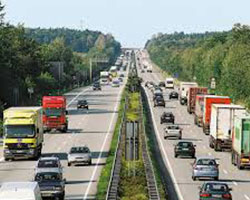<< Research Projects Overview << Year One Projects Overview
Eco-Driving Study on Trucks Along a Signalized Arterial with Significant Freight Traffic

Professor, Zachry Department of Civil Engineering
Texas A&M University
yzhang@civil.tamu.edu
Proposal Summary and Objectives
Eco-driving is a concept of reducing fuel consumption and greenhouse gas emissions through changing driving behaviors. Along with a signalized arterial, frequent driving mode changes in decelerating, stopping/idling, and accelerating contribute to elevated levels of fuel consumption and emissions. Because of the extra distance and time needed for deceleration and acceleration of heavy trucks, and because of the significantly alleviated fuel consumption rate and emission rates during the acceleration processes of these trucks, the driving decisions of the trucks not only have major impacts on the mobility but also have significant environmental and economic impacts.
The objective of this research is to develop eco-driving strategies by optimizing the speed profiles of the trucks along a signalized arterial to minimize fuel consumption and emission while maintaining good mobility of the corridor. Two significant differences exist between this proposed study and prior studies. Firstly, the study has a focus on trucks which have distinct characteristics in acceleration, deceleration, and speed. These characters will have significant impacts on traffic operations as well as fuel consumption and emissions for an arterial with significant freight traffic. Secondly, this study will specifically consider market penetration and compliance rate of eco-driving from truck drivers and other drivers. The market penetration and compliance rates will significantly affect the results of optimization and also call for different modeling approaches, from a deterministic one to one that is probabilistic and considers uncertainties.
The optimization is based on current traffic conditions including current truck speed modes and the queuing conditions at the downstream intersection and also based on the current signal states including SPaT data. A queue detection algorithm considering the connected vehicle market penetration rate will be considered. Evaluations will be made for different scenarios of traffic and signal conditions with both a macroscopic procedure and a microscopic approach that integrates EPA’s MOVES models with a microscopic traffic simulation program (VISSIM). The optimization solutions based on mobility considering trucks as well as cars will also be compared with those that minimize fuel consumption and emissions, and integrated optimization strategies will be explored.
This research will also explore the additional benefits in mobility, fuel consumption, and air quality by considering the interactions of signal control and truck eco-driving decisions under a connected operation environment. Trucks will be assumed to be connected (or have a high market penetration rate) and communicate with the infrastructure (signal control), and the benefits from the combination of eco-driving decisions in real time and adaptive signal control will be further evaluated, and strategies and methodology for real-time implementation will be explored.
Funding Amount: $70,000
Status: Complete
Duration: July 1, 2017 - Aug. 30, 2018